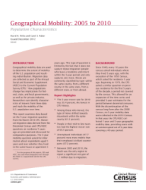Geographical Mobility: 2005 to 2010
Geographical Mobility: 2005 to 2010
Introduction
Geographical mobility data are used to determine the extent of mobility of the U.S. population and resulting redistribution. Migration data are collected as part of the Annual Social and Economic Supplement (ASEC) to the Current Population Survey (CPS). How populations change has implications for federal, state, and local governments, as well as for private industry. Researchers can identify characteristics of movers from these data and track the mobility of the U.S. population over time. For the purpose of this report, CPS and ASEC are used interchangeably even though the ASEC is a supplement within the CPS survey.
This report examines data based on the 5-year migration question from the March 2010 CPS. Historical migration data derived from the Decennial Census and CPS/ASEC questions on residence 5 years ago are provided and discussed for comparative purposes. The 5-year mobility question asked for information about respondents aged 5 years and over whether they lived in the same house or apartment 5 years ago. This type of question is limited by the fact that it does not capture repeat migration (people who leave a residence and return within the 5-year period) and only captures one move. Moves are commonly classified by type: within the same county, from a different county in the same state, from a different state, or from abroad.
Report Highlights
- The 5-year mover rate for 2010 was 35.4 percent, the lowest in CPS history.
- Among those who moved, the type of move shifted towards movement within the same county (61.0 percent).
- People in their mid to late twenties had the highest mover rate of 65.5 percent.
- Unemployed individuals (47.7 percent) were more mobile than their employed (civilian) counterparts (37.2 percent).
- Between 2005 and 2010, the South was the only region to report a significant net gain of 1.1 million due to migration.
Table 1. General Mobility, by Race and Hispanic Origin, Region, Sex, Age, Relationship to Householder, Educational Attainment, Marital Status, Nativity, Tenure, and Poverty Status : 2005 to 2010
Table 2. General Mobility of Persons 16 Years and Over, by Sex, Age, Race and Hispanic Origin, Region, and Labor Force Status: 2005 to 2010
Table 3. General Mobility of Employed Civilians 16 Years and Over, by Sex, Age, Race and Hispanic Origin, Region, and Major Occupation Group: 2005 to 2010
Table 4. General Mobility of Employed Civilians 16 Years and Over, by Sex, Age, Race and Hispanic Origin, Region, and Major Industry Group: 2005 to 2010
Table 5. General Mobility of Persons 15 Years and Over, by Sex, Age, Race and Hispanic Origin, Region, and Income in 2009: 2005 to 2010
Table 6. General Mobility, by Sex, Age, and Relationship to Householder: 2005 to 2010
Table 7. General Mobility, by Age, Race and Hispanic Origin, and Tenure: 2005 to 2010
Table 8. General Mobility of Family Householders, by Type of Household, Age of Householder, and Presence and Age of Own Children Under 18: 2005 to
Table 9. General Mobility of Family Householders, by Type of Household, Race and Hispanic Origin of Householder, and Presence and Age of Own Children Under 18: 2005 to 2010
Table 10. General Mobility of Householders, by Sex, Age, Race and Hispanic Origin, Region, Tenure, and Household Income in 2009: 2005 to 2010
Table 11. Inmigrants, Outmigrants, and Net Domestic Migration for Regions, by Sex, Age, Race and Hispanic Origin, Relationship to Householder, Educational Attainment, Marital Status, Nativity, Tenure, and Poverty Status: 2005 to 2010
Table 12. Inmigrants, Outmigrants, and Net Domestic Migration for Regions, by Income in 2009, Labor Force Status, Major Occupation Group, and Major Industry Group: 2005 to 2010
Table 13. Migration Flows Between Regions, by Sex, Age, Race and Hispanic Origin, Relationship to Householder, Educational Attainment, Marital Status, Nativity, Tenure, and Poverty Status: 2005 to 2010
Table 14. Migration Flows Between Regions, by Income in 2009, Labor Force Status, Major Occupation Group, and Major Industry Group: 2005 to 2010
Table 15. Inmigration, Outmigration, and Net Domestic Migration by Metro Status, Sex, Age, Race and Hispanic Origin, Relationship to Householder, Educational Attainment, Marital Status, Nativity, Tenure, Poverty Status, Income in 2009, Labor Force Status,
Table 16. Metropolitan Mobility, by Sex, Age, Race and Hispanic Origin, Relationship to Householder, Educational Attainment, Marital Status, Nativity, Tenure, and Poverty Status: 2005 to 2010
Table 17. Metropolitan Mobility of Persons 16 Years and Over, by Sex, Age, Race and Hispanic Origin, and Labor Force Status: 2005 to 2010
Table 18. Metropolitan Mobility of Employed Civilians 16 Years and Over, by Sex, Race and Hispanic Origin, and Major Occupation Group: 2005 to 2010
Table 19. Metropolitan Mobility of Employed Civilians 16 Years and Over, by Sex, Race and Hispanic Origin, and Major Industry Group: 2005 to 2010
Table 20. Metropolitan Mobility of Persons 15 Years and Over, by Sex, Race and Hispanic Origin, and Income in 2009: 2005 to 2010
Table 21. Metropolitan Mobility of Family Householders, by Type of Household, and Presence and Age of Own Children Under 18: 2005 to 2010
Table 22. Metropolitan Mobility of Householder, by Sex, Race and Hispanic Origin, Tenure, and Household Income in 2009: 2005 to 2010
Table 23. Distance of Intercounty Move by Sex, Age, Race and Hispanic Origin, Relationship to Householder, Educational Attainment, Marital Status, Nativity, Tenure, Poverty Status, and State of Residence 5 Years Ago: 2005 to 2010
Table 24. Distance of Intercounty Move of Movers 16 Years and Over, by Household Income in 2009, Labor Force Status, Major Occupation Group, Major Industry Group: 2005 to 2010
Others in Series
Publication
Publication
Publication







